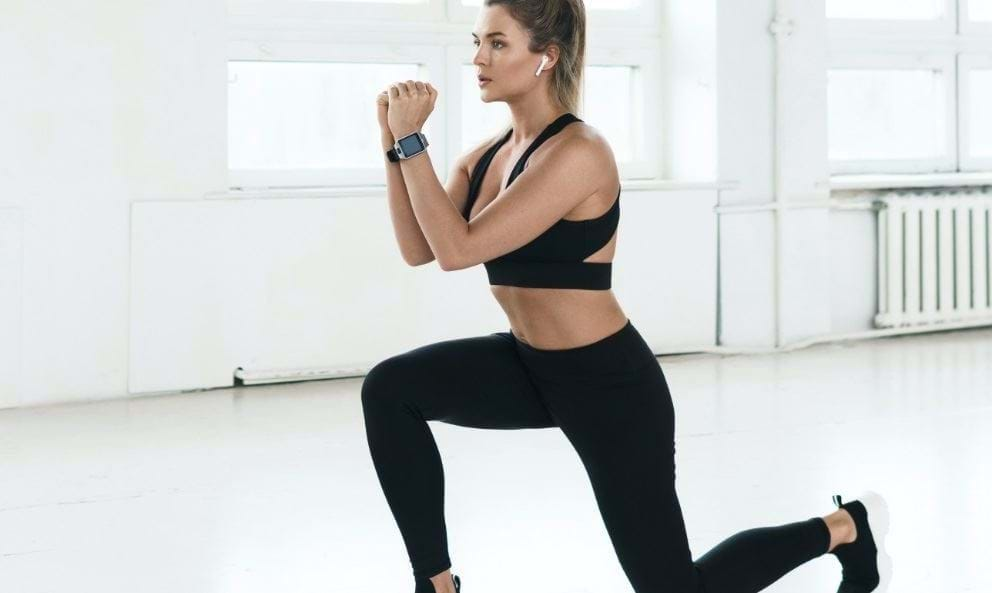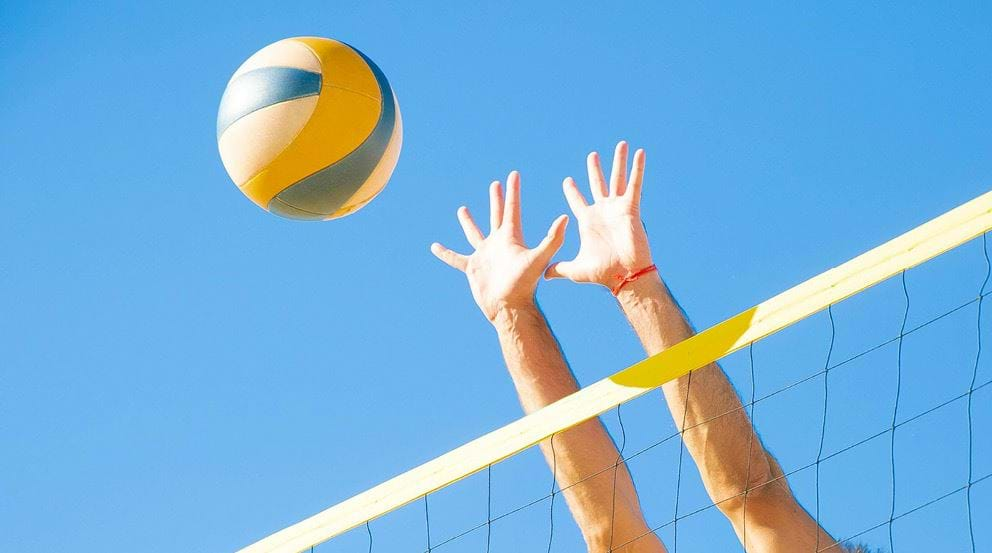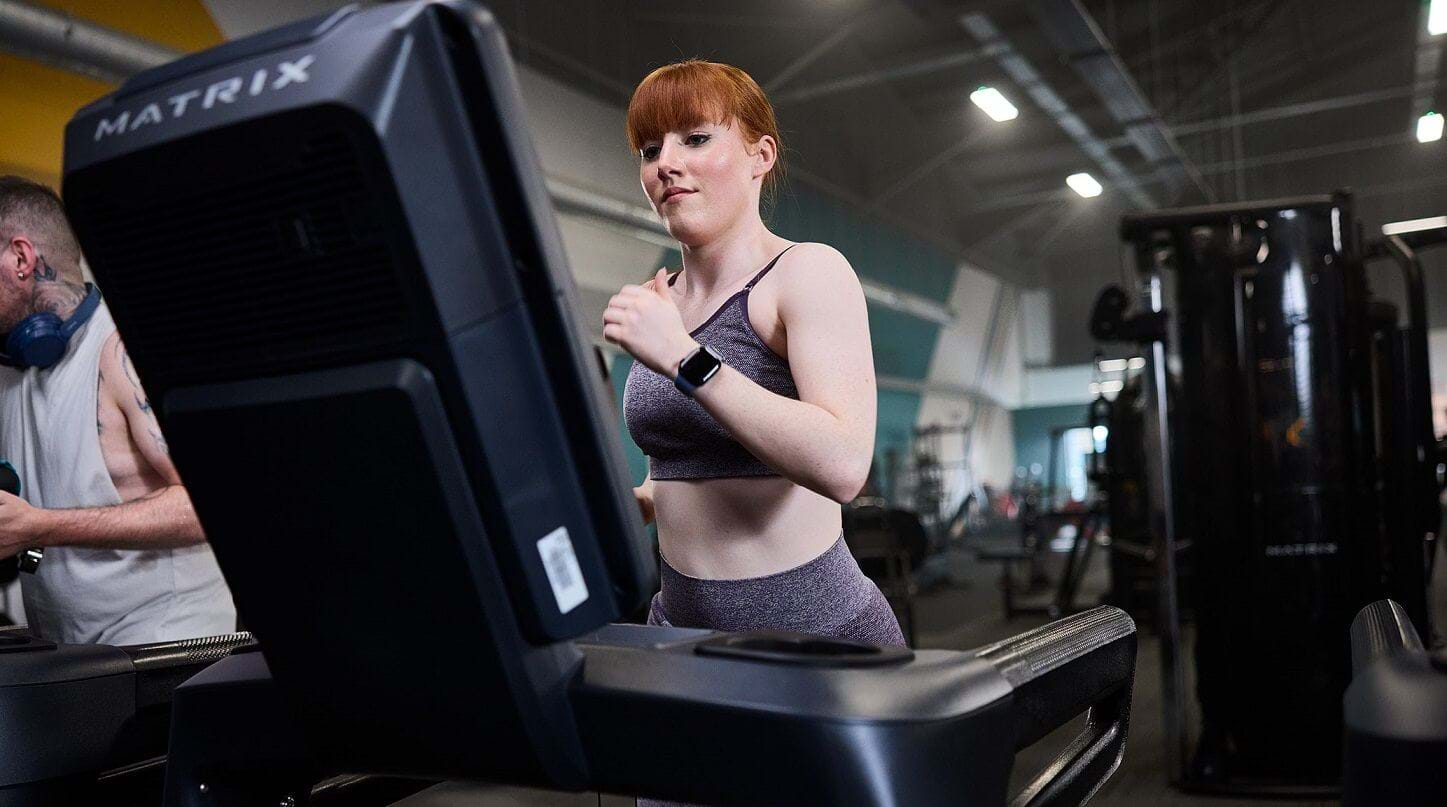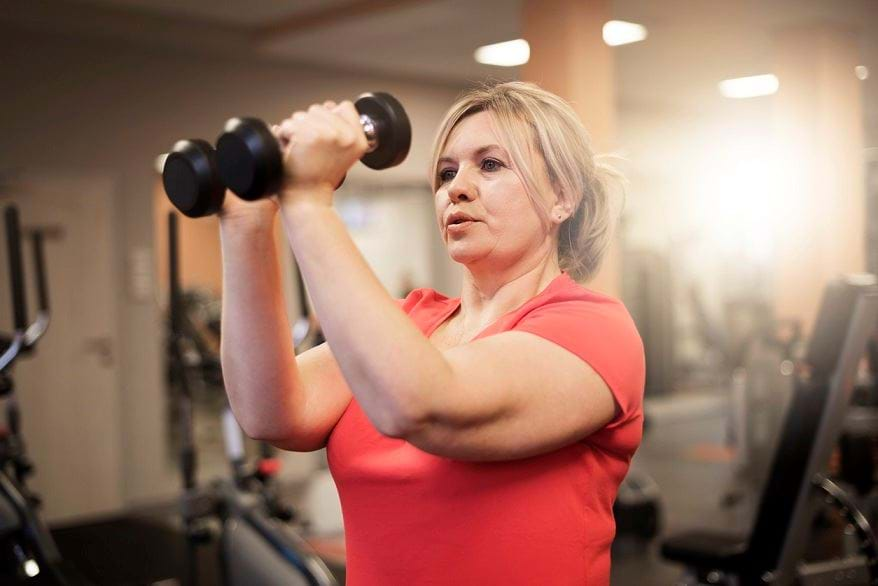10 Low Impact HIIT Exercises and Workouts That Won’t Hurt Your Knees or Back

What Is Low Impact Exercise | What Is A Low Impact HIIT Exercise | The Benefits | No Jumping Exercises | Low Impact Exercises
What is low impact exercise?
Page last updated: 14th January 2025
Low impact exercises put less strain or pressure on your body, particularly the joints and bones, than higher impact training. Low impact doesn't mean low intensity, and if done correctly can offer all the same benefits as HIIT and other workout types.
A good example of high and low impact exercise is running vs swimming. With every stride on a run, the bones, tendons, and joints in your leg absorbs up to 4 times your body weight in force. That's a lot of pressure on your ankles, knees, and hips! With swimming, on the other hand, the buoyancy of water supports your weight and allows you to achieve a full body workout without putting pressure on your joints. Running would be considered higher impact exercise, while swimming is a low impact exercise.
There are lots of low impact exercises you can try, and most high impact exercises can also be modified to make them easier on your joints too.
What is low impact exercise?
Low impact exercises put less strain or pressure on your body, particularly the joints and bones, than higher impact training. Low impact doesn't mean low intensity, and if done correctly can offer all the same benefits as HIIT and other workout types.
A good example of high and low impact exercise is running vs swimming. With every stride on a run, the bones, tendons, and joints in your leg absorbs up to 4 times your body weight in force. That's a lot of pressure on your ankles, knees, and hips! With swimming, on the other hand, the buoyancy of water supports your weight and allows you to achieve a full body workout without putting pressure on your joints. Running would be considered higher impact exercise, while swimming is a low impact exercise.
There are lots of low impact exercises you can try, and most high impact exercises can also be modified to make them easier on your joints too.
What is a low impact HIIT workout?
HIIT stands for High Intensity Interval Training and is an exercise format that involves periods of maximum effort movement followed by periods of lower intensity or full rest. HIIT training can be used in different ways by applying the interval format to your favourite form of exercise - running, rowing, elliptical, swimming, functional training and more.
Low impact HIIT workouts (sometimes referred to as High Intensity Low Impact Training or HILIT) takes on the same format as regular HIIT workouts, but with a focus on lower impact exercises. Many HIIT workouts will feature high impact movements like burpees, jumping jacks, or squat jumps, as these are great at raising your heart rate and using big spurts of energy. Low impact HIIT workouts either avoid these kind of high impact exercises or offer alternative options that are softer on the joints. This is particularly important if you're looking for a 'no jumping' exercise and workout.
For example, while HIIT running is an excellent way to improve strength, stamina and endurance, it can take its toll on joints. A lower impact alternative might be using the elliptical, stationary bike or rower instead. If you love running and don't want to quit, running on a treadmill is a lower impact option than road running (our Treadmill vs Outside Running article explains more).
What are the benefits of low impact HIIT workouts?
HIIT training has many benefits, but is often favoured as a quick, convenient approach to training, with studies showing that 15-20 minutes of HIIT training can have the same (if not more) of an effect on fitness and endurance as 45 minutes of standard cardio (check out our HIIT benefits guide to learn more).
Low impact HIIT workouts still get your heart rate up, burn calories, improve your cardiovascular fitness and muscular strength, but put less pressure on your joints. This makes HIIT training more accessible to a wider range of people, making it helpful for:
Beginners - if you're just starting out on your fitness journey, easing in with lower impact HIIT workouts will help you to build up your strength and skills without risking injury
Injury recovery - do you suffer from knee pain? Or maybe you get shin splints when you run? Whether you have an injury or experience soreness and joint stiffness when you work out, low impact adaptations mean you can still enjoy the benefits of a workout without unnecessarily exacerbating any issues
Home workouts - if you're working out at home, particularly in an apartment, heavy jumping movements can be a sure-fire way to make enemies with your neighbours. Likewise, if you're working out during a child's nap time, or squeezing in some exercise before the rest of your household is awake, higher impact workouts can be harder to keep quiet. Low impact HIIT means you can stick to your fitness regime without disturbing others in the building
Seniors - bone density can start to drop once we pass the age of 50, so exercise that improves overall health and fitness and builds strength, without putting pressure on the joints is an excellent approach
Overweight individuals - if you're carrying more weight, you're naturally placing more pressure on your joints and bones. It can be helpful to start with low impact movements and work up to higher impact to avoid injury
Although low impact workouts are more accessible to these groups, it is still important to check with your doctor before starting a new workout routine.
No Jumping - The Exercises to Avoid
Your low impact workout plan should also focus on eliminating exercises that include jumping or sharp, high-impact movements. This rules out most jumping-based exercise as they often place significant strain on joints like the knees, hips, and ankles.
For those aiming for a no-jumping approach, here are some exercises to steer clear of and their alternatives:
Burpees
Jumping jacks
squat jumps
Mountain climbers
High knees
The No Jumping Advantage
Incorporating no-jumping exercises into your low impact HIIT workouts doesn't just protect your joints, it also comes with a few benefits:
Adaptability: No-jumping workouts can be performed almost anywhere, including spaces with low ceilings or hard floors.
Silent workouts: Ideal if you're working out from home! No jumping exercises are perfect for early mornings, late evenings, or any time when you want to minimise noise.
Sustainable progression: By reducing the risk of injury, you can consistently train over time without needing to take breaks for recovery.
10 Low Impact Exercises for Your Next HIIT Workout
Depending on your skill levels, injury or whether you suffer from joint problems, you can tailor a HIIT workout to suit your needs. All the exercises below will be sure to raise your heart rate and boost your VO2 max, while being a little gentler on your joint.
For a snappy 15-minute, low impact HIIT workout, pick five exercises from the listns below. Complete 40 seconds high intensity followed by 20 seconds rest and work through each movement for one set. Repeat for three sets. Don't forget to warm up first and stretch out afterwards.
Squat to overhead reach
While a simple squat is a firm workout favourite, adding in an overhead reach makes this a great full body movement.
Start with your feet just wider than hip width apart and arms down at your sides
Bend your knees while driving your hips backwards (like you're sitting on a chair) and try not to let your knees cross in front of your toes
As you squat, raise your arms upwards, so they're straight above your head
Drive back to standing using your quads and glutes, while lowering your arms back to your starting position
Want more intensity? Try holding dumbbells throughout or speed up the tempo. Check out our squats page for more variations to try.
Plank toe taps
Planks are an awesome low impact core exercise and will really set your abs are fire. Plank toe taps also engage your shoulders and glutes too!
Start in a push up position with toes pressed into the floor, around hip-width apart and palms on the ground below your shoulders
Lower down into a classic plank position with your forearms on the floor. Engage your core and try to keep your upper body stable as you lift your left foot and tap it out as far as you can to the side, before returning back to the plank and alternating with the right foot
Check out our plank page for more variations to try.
Glute bridges (hip thrusts)
Great for strengthening your lower back, hamstrings, core and, of course, glutes, glute bridges are an excellent low impact choice. Check out our glute bridge page for more variations to try.
Lie down on a mat, with your knees bent and feet around hip width apart
Place your hands by your side for support, engage your core and lift your hips off the ground
Raise until your shoulders, hips and knees form a straight line. Hold for a moment before lowering
Repeat!
If you want to make this exercise more challenging hold a dumbbell or weight plate on your hips. Alternatively, you can also add a resistance band loop just above your knees to increase glute activation.
Kettlebell swings
Kettlebell swings are a fantastic, functional exercise that works your core, shoulders, back and lower body, and when done correctly they shouldn't put too much strain on your joints. All our gyms are well stocked with kettlebells in a range of sizes to suit all abilities.
Start standing with your feet just wider than hip width apart and the kettlebell between your feet
Crouch into a half squat, pick up the kettlebell with your hands facing inwards towards your body
Hinge at your hips to swing the kettlebell between your legs
Squeeze your glutes and thrust your hips forward, using the momentum to swing the weight up to chest height
Hinge at the hips again and repeat in a smooth and controlled motion
Check out our kettlebell swings page for more variations to try.
Low impact burpees
Burpees are renowned for being a full body exercise that's high energy and high intensity - perfect for a HIIT session! While they usually involve jumping elements that can be tough on joints, they can be adjusted to fit in your low impact workout.
Start in a standing position with feet hip width apart
Engage your core, and squat down until you can place your hands on the floor in front of you.
Step each foot back until you're in a plank position and then drop down into a push up (if you can... if not you can skip that bit!)
Step each foot back to your squat position and return to standing
Instead of doing a jump, simply raise your arms up to the sky and then slowly return to your starting position ready for another rep
Check out our how to do burpees page to see how to complete a classic burpee.
Russian twists
Russian twists are a great way to target your core without any impact on your knees and joints. If you find this too challenging or you're wobbling a little, gently touch your feet to the floor instead while you twist.
Sit on the floor or on a mat with your knees bent. If you have one, hold a weight, like a plate or dumbbell in both hands
Lift your heels off the ground and lean back slightly. Brace your abs and twist your torso to the right side until your arms are parallel with the floor
Rotate back to the starting position while breathing out. Then move to the opposite side by twisting your core and repeat
Low impact jumping jacks (power jacks)
Jumping jacks are another HIIT staple move, but they can put a lot of pressure on the knees. You can soften the blow of a classic jumping jack by switching to a low impact alternative which focuses on power instead.
Like a regular jumping jack, start in a standing position with hands at your sides
Instead of a classic jumping jack take the jump out and instead alternate one side at a time
Bend your left knee slightly and step your right foot out to the side, swinging your right arm up to above shoulder height
Step back in and repeat on the left-hand side. This should be a swift movement, maintaining strength and power through your arms and legs as you move
Inchworm
The inchworm targets your full body and works up a sweat without putting any strain on your joints.
Starting in a tall standing position, bend forward at the waist until your arms touch the floor
Use your arms to walk your body out straight and then do a press up
Walk your arms back up to your feet
Stand straight and repeat
Lateral lunges (side lunges)
Lunges of all kinds will target your hips, legs, and glutes, and most options are already fairly low impact - just avoid any that involve jumping. The lateral lunge is a great variation which works the gluteus medius (the side of your glutes) which supports your hip joint.
Begin by standing with feet roughly shoulder width apart
Brace your core, keep your body upright and take a big step out to the side with your right leg and lower till your right knee is at roughly 90 degrees
You can extend your arms out in front of you, put your hands on your hips or gently place your hand on your bent leg for support
Drive through your bent leg, squeezing your glutes and engaging your quads to push back up to your starting position
Repeat your desired reps on this side and then repeat on the other leg
This can be made more challenging by holding weights such as dumbbells or a kettlebell. Check out our lunges page for more variations to try.
Boxing punches
Burn off energy and release stress with some boxing punches. You can choose which style you prefer, or even try a mix of straight punches, upper cuts, and side punches.
Keep your shoulder down, a light bend in your knees and plenty of power behind the punches
Make sure to use controlled movements to keep it low impact
If you'd like to make this more challenging, drop it down into a squat or a sumo squat position while you punch. This full body adjustment will work your legs and upper body in one!
Low impact cardio workout
Find the idea of a HIIT workout too daunting? Try this low impact cardio workout instead - don't worry, it'll still get your heart racing!
Ready for Your Workout?
If you struggle with knee pain from running, check out our running knee pain Q&A with run coach Ian. Ready to do some HIIT? Head to your nearest PureGym and start today! For more workout inspiration, download the free PureGym app.
Or, if you're still not sure which type of workout will best suit your needs, perhaps consider booking a personal trainer session with a personal trainer at PureGym. They will be able to help you adapt your workouts whether you're a beginner or gym pro.


